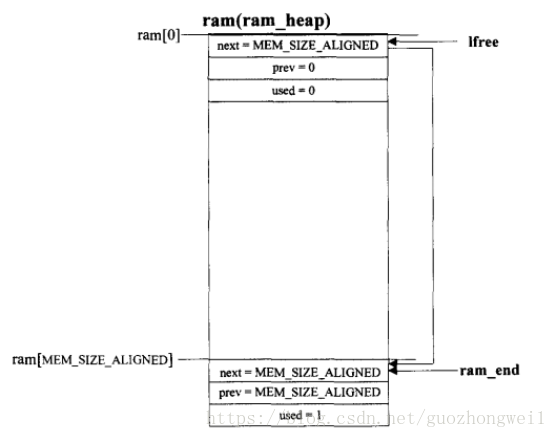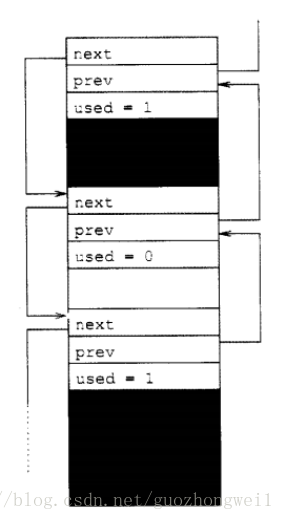本章分析动态内存堆(HEAP)的第一种分配策略,承接上篇文章
LwIP 协议栈源码分析(读书笔记)–内存管理–机制策略分析
组织形式:


mem.c源码解析如下:
mem_init():
/**
* Zero the heap and initialize start, end and lowest-free
*/
void
mem_init(void)
{
struct mem *mem;
LWIP_ASSERT("Sanity check alignment",
(SIZEOF_STRUCT_MEM & (MEM_ALIGNMENT-1)) == 0);//内存大小对齐及检测
/* align the heap */
ram = (u8_t *)LWIP_MEM_ALIGN(LWIP_RAM_HEAP_POINTER);//堆地址 对齐
/* initialize the start of the heap==初始化堆链表的头结点 */
mem = (struct mem *)(void *)ram;//指针类型强转为链表
mem->next = MEM_SIZE_ALIGNED;//#define MEM_SIZE 16000 //内存堆heap大小
mem->prev = 0;
mem->used = 0;
/* initialize the end of the heap==初始化堆链表的结束结点 */
ram_end = (struct mem *)(void *)&ram[MEM_SIZE_ALIGNED];
ram_end->used = 1;//指明用户不可用
ram_end->next = MEM_SIZE_ALIGNED;
ram_end->prev = MEM_SIZE_ALIGNED;
/* initialize the lowest-free pointer to the start of the heap==
**指向最低空闲块的指针,这用于更快的搜索 */
lfree = (struct mem *)(void *)ram;
MEM_STATS_AVAIL(avail, MEM_SIZE_ALIGNED);
if(sys_mutex_new(&mem_mutex) != ERR_OK) {//new一个互斥信号量 mem_mutex,名字看出,内存管理专用
LWIP_ASSERT("failed to create mem_mutex", 0);
}
}
}内存对齐操作:SIZEOF_STRUCT_MEM
#define SIZEOF_STRUCT_MEM LWIP_MEM_ALIGN_SIZE(sizeof(struct mem))关于字节对齐算法:LWIP_MEM_ALIGN_SIZE()
参见:字节对齐算法
进行此项操作的理由:lwip按自己的内存对齐规则管理维护内部的数据,不受编译器的对齐规则影响。
/** pointer to the heap (ram_heap): for alignment, ram is now a pointer instead of an array== 堆起始地址*/
static u8_t *ram;
/** the last entry, always unused! ==最后一项,不会被使用*/
static struct mem *ram_end;
/** pointer to the lowest free block, this is used for faster search *==指向最低空闲块的指针,这用于更快的搜索*/
static struct mem *lfree;mem_malloc( ) :
/**
* Adam's mem_malloc() plus solution for bug #17922
* Allocate a block of memory with a minimum of 'size' bytes.
*
* @param size is the minimum size of the requested block in bytes.
* @return pointer to allocated memory or NULL if no free memory was found.
*
* Note that the returned value will always be aligned (as defined by MEM_ALIGNMENT).
*/
void *
mem_malloc(mem_size_t size)
{
mem_size_t ptr, ptr2;
struct mem *mem, *mem2;
#if LWIP_ALLOW_MEM_FREE_FROM_OTHER_CONTEXT
u8_t local_mem_free_count = 0;
#endif /* LWIP_ALLOW_MEM_FREE_FROM_OTHER_CONTEXT */
LWIP_MEM_ALLOC_DECL_PROTECT();//
if (size == 0) {
return NULL;
}
/* Expand the size of the allocated memory region so that we can
adjust for alignment. */
size = LWIP_MEM_ALIGN_SIZE(size);//对齐
if(size < MIN_SIZE_ALIGNED) {
/* every data block must be at least MIN_SIZE_ALIGNED long */
size = MIN_SIZE_ALIGNED;
}
if (size > MEM_SIZE_ALIGNED) {
return NULL;
}
/* protect the heap from concurrent access */
sys_mutex_lock(&mem_mutex);//保护堆不受并发访问
LWIP_MEM_ALLOC_PROTECT();
#if LWIP_ALLOW_MEM_FREE_FROM_OTHER_CONTEXT//未定义,无do--while
/* run as long as a mem_free disturbed mem_malloc or mem_trim */
do {
local_mem_free_count = 0;
#endif /* LWIP_ALLOW_MEM_FREE_FROM_OTHER_CONTEXT */
/* Scan through the heap searching for a free block that is big enough,
* beginning with the lowest free block.
*/
for (ptr = (mem_size_t)((u8_t *)lfree - ram)/*上次分配内存后的最低lfree节点地址*/; ptr < MEM_SIZE_ALIGNED - size/*分配后剩余大小*/;
ptr = ((struct mem *)(void *)&ram[ptr])->next/*指向下一个结点*/) {
mem = (struct mem *)(void *)&ram[ptr];
if ((!mem->used) &&//该块内存未使用
(mem->next - (ptr + SIZEOF_STRUCT_MEM)) >= size/*相应的内存大小够用*/) {
/* mem is not used and at least perfect fit is possible:
* mem->next - (ptr + SIZEOF_STRUCT_MEM) gives us the 'user data size' of mem */
if (mem->next - (ptr + SIZEOF_STRUCT_MEM) >= (size + SIZEOF_STRUCT_MEM + MIN_SIZE_ALIGNED)) {//是否能够拆分该节点的数据块
/* (in addition to the above, we test if another struct mem (SIZEOF_STRUCT_MEM) containing
* at least MIN_SIZE_ALIGNED of data also fits in the 'user data space' of 'mem')
* -> split large block, create empty remainder,
* remainder must be large enough to contain MIN_SIZE_ALIGNED data: if
* mem->next - (ptr + (2*SIZEOF_STRUCT_MEM)) == size,
* struct mem would fit in but no data between mem2 and mem2->next
* @todo we could leave out MIN_SIZE_ALIGNED. We would create an empty
* region that couldn't hold data, but when mem->next gets freed,
* the 2 regions would be combined, resulting in more free memory
*/
ptr2 = ptr + SIZEOF_STRUCT_MEM + size;//分割内存后,剩余部分的地址
/* create mem2 struct//新建一个结点维护剩余的内存 */
mem2 = (struct mem *)(void *)&ram[ptr2];
mem2->used = 0;
mem2->next = mem->next;
mem2->prev = ptr;
/* and insert it between mem and mem->next */
mem->next = ptr2;
mem->used = 1;
if (mem2->next != MEM_SIZE_ALIGNED) {//非最后一个结点(中间结点)
((struct mem *)(void *)&ram[mem2->next])->prev = ptr2;//更新后边的prev地址,完成链表的插入
}
MEM_STATS_INC_USED(used, (size + SIZEOF_STRUCT_MEM));
} else {//不能够拆分,更新used成员为已使用
/* (a mem2 struct does no fit into the user data space of mem and mem->next will always
* be used at this point: if not we have 2 unused structs in a row, plug_holes should have
* take care of this).
* -> near fit or excact fit: do not split, no mem2 creation
* also can't move mem->next directly behind mem, since mem->next
* will always be used at this point!
*/
mem->used = 1;
MEM_STATS_INC_USED(used, mem->next - (mem_size_t)((u8_t *)mem - ram));
}
if (mem == lfree) {//查找空闲的 没有被使用的节点,方便下次调用
struct mem *cur = lfree;
/* Find next free block after mem and update lowest free pointer */
while (cur->used && cur != ram_end) {
#if LWIP_ALLOW_MEM_FREE_FROM_OTHER_CONTEXT
mem_free_count = 0;
LWIP_MEM_ALLOC_UNPROTECT();
/* prevent high interrupt latency... */
LWIP_MEM_ALLOC_PROTECT();
if (mem_free_count != 0) {
/* If mem_free or mem_trim have run, we have to restart since they
could have altered our current struct mem or lfree. */
goto mem_malloc_adjust_lfree;
}
#endif /* LWIP_ALLOW_MEM_FREE_FROM_OTHER_CONTEXT */
cur = (struct mem *)(void *)&ram[cur->next];
}
lfree = cur;//更新lfree
LWIP_ASSERT("mem_malloc: !lfree->used", ((lfree == ram_end) || (!lfree->used)));
}
LWIP_MEM_ALLOC_UNPROTECT();
sys_mutex_unlock(&mem_mutex);//解锁内存互斥信号量
LWIP_ASSERT("mem_malloc: allocated memory not above ram_end.",
(mem_ptr_t)mem + SIZEOF_STRUCT_MEM + size <= (mem_ptr_t)ram_end);//边界检查
LWIP_ASSERT("mem_malloc: allocated memory properly aligned.",
((mem_ptr_t)mem + SIZEOF_STRUCT_MEM) % MEM_ALIGNMENT == 0);//对齐检查
LWIP_ASSERT("mem_malloc: sanity check alignment",
(((mem_ptr_t)mem) & (MEM_ALIGNMENT-1)) == 0);//对齐检查
return (u8_t *)mem + SIZEOF_STRUCT_MEM;
}
}
#if LWIP_ALLOW_MEM_FREE_FROM_OTHER_CONTEXT
/* if we got interrupted by a mem_free, try again */
} while(local_mem_free_count != 0);
#endif /* LWIP_ALLOW_MEM_FREE_FROM_OTHER_CONTEXT */
LWIP_DEBUGF(MEM_DEBUG | LWIP_DBG_LEVEL_SERIOUS, ("mem_malloc: could not allocate %"S16_F" bytes\n", (s16_t)size));
MEM_STATS_INC(err);
LWIP_MEM_ALLOC_UNPROTECT();
sys_mutex_unlock(&mem_mutex);
return NULL;
}
流程描述:
从lfree空闲块节点开始,确认used成员,比较节点内存时候够用,否则向后查找。
一旦找到,判断下能够分割,
能分割,意味着需要插入一个节点到链表。
否则,更新used成员为已使用。
找到合适的内存后,更新lfree空闲块儿指针;
检查对齐,
return 数据内存地址(需要去掉维护链表节点的内存)
mem_calloc( ):
/**
* Contiguously allocates enough space for count objects that are size bytes
* of memory each and returns a pointer to the allocated memory.
*
* The allocated memory is filled with bytes of value zero.
*
* @param count number of objects to allocate
* @param size size of the objects to allocate
* @return pointer to allocated memory / NULL pointer if there is an error
*/
void *mem_calloc(mem_size_t count, mem_size_t size)
{
void *p;
/* allocate 'count' objects of size 'size' */
p = mem_malloc(count * size);//分配内存
if (p) {
/* zero the memory */
memset(p, 0, count * size);//清零
}
return p;
}对mem_malloc进行封装====清零已分配的内存。
mem_free():
/**
* Put a struct mem back on the heap
*
* @param rmem is the data portion of a struct mem as returned by a previous
* call to mem_malloc()
*/
void
mem_free(void *rmem)
{
struct mem *mem;
LWIP_MEM_FREE_DECL_PROTECT();
if (rmem == NULL) {
LWIP_DEBUGF(MEM_DEBUG | LWIP_DBG_TRACE | LWIP_DBG_LEVEL_SERIOUS, ("mem_free(p == NULL) was called.\n"));
return;
}
LWIP_ASSERT("mem_free: sanity check alignment", (((mem_ptr_t)rmem) & (MEM_ALIGNMENT-1)) == 0);
LWIP_ASSERT("mem_free: legal memory", (u8_t *)rmem >= (u8_t *)ram &&
(u8_t *)rmem < (u8_t *)ram_end);
if ((u8_t *)rmem < (u8_t *)ram || (u8_t *)rmem >= (u8_t *)ram_end) {
SYS_ARCH_DECL_PROTECT(lev);
LWIP_DEBUGF(MEM_DEBUG | LWIP_DBG_LEVEL_SEVERE, ("mem_free: illegal memory\n"));
/* protect mem stats from concurrent access */
SYS_ARCH_PROTECT(lev);
MEM_STATS_INC(illegal);
SYS_ARCH_UNPROTECT(lev);
return;
}
/* protect the heap from concurrent access */
LWIP_MEM_FREE_PROTECT();
/* Get the corresponding struct mem ... */
mem = (struct mem *)(void *)((u8_t *)rmem - SIZEOF_STRUCT_MEM);//确定相关链表节点
/* ... which has to be in a used state ... */
LWIP_ASSERT("mem_free: mem->used", mem->used);
/* ... and is now unused. */
mem->used = 0;//更新该块内存为未使用
if (mem < lfree) {//更新lfree
/* the newly freed struct is now the lowest */
lfree = mem;
}
MEM_STATS_DEC_USED(used, mem->next - (mem_size_t)(((u8_t *)mem - ram)));
/* finally, see if prev or next are free also */
plug_holes(mem);//整合相邻的节点,满足条件则合并
#if LWIP_ALLOW_MEM_FREE_FROM_OTHER_CONTEXT
mem_free_count = 1;
#endif /* LWIP_ALLOW_MEM_FREE_FROM_OTHER_CONTEXT */
LWIP_MEM_FREE_UNPROTECT();
}
释放内存,并整合相邻的资源。
mem_trim():
/**
* Shrink memory returned by mem_malloc().
*
* @param rmem pointer to memory allocated by mem_malloc the is to be shrinked
* @param newsize required size after shrinking (needs to be smaller than or
* equal to the previous size)
* @return for compatibility reasons: is always == rmem, at the moment
* or NULL if newsize is > old size, in which case rmem is NOT touched
* or freed!
*/
void *
mem_trim(void *rmem, mem_size_t newsize)
{
mem_size_t size;
mem_size_t ptr, ptr2;
struct mem *mem, *mem2;
/* use the FREE_PROTECT here: it protects with sem OR SYS_ARCH_PROTECT */
LWIP_MEM_FREE_DECL_PROTECT();
/* Expand the size of the allocated memory region so that we can
adjust for alignment. */
newsize = LWIP_MEM_ALIGN_SIZE(newsize);
if(newsize < MIN_SIZE_ALIGNED) {
/* every data block must be at least MIN_SIZE_ALIGNED long */
newsize = MIN_SIZE_ALIGNED;
}
if (newsize > MEM_SIZE_ALIGNED) {
return NULL;
}
LWIP_ASSERT("mem_trim: legal memory", (u8_t *)rmem >= (u8_t *)ram &&
(u8_t *)rmem < (u8_t *)ram_end);
if ((u8_t *)rmem < (u8_t *)ram || (u8_t *)rmem >= (u8_t *)ram_end) {
SYS_ARCH_DECL_PROTECT(lev);
LWIP_DEBUGF(MEM_DEBUG | LWIP_DBG_LEVEL_SEVERE, ("mem_trim: illegal memory\n"));
/* protect mem stats from concurrent access */
SYS_ARCH_PROTECT(lev);
MEM_STATS_INC(illegal);
SYS_ARCH_UNPROTECT(lev);
return rmem;
}
/* Get the corresponding struct mem ... */
mem = (struct mem *)(void *)((u8_t *)rmem - SIZEOF_STRUCT_MEM);//获取输入的rmem内存地址的链表节点
/* ... and its offset pointer */
ptr = (mem_size_t)((u8_t *)mem - ram);//索引
size = mem->next - ptr - SIZEOF_STRUCT_MEM;//节点内存块的大小
LWIP_ASSERT("mem_trim can only shrink memory", newsize <= size);
if (newsize > size) {
/* not supported */
return NULL;
}
if (newsize == size) {
/* No change in size, simply return */
return rmem;
}
/* protect the heap from concurrent access */
LWIP_MEM_FREE_PROTECT();
mem2 = (struct mem *)(void *)&ram[mem->next];//下一个节点
if(mem2->used == 0) {//空闲,则剩余部分与下一个节点合并
/* The next struct is unused, we can simply move it at little */
mem_size_t next;
/* remember the old next pointer */
next = mem2->next;
/* create new struct mem which is moved directly after the shrinked mem */
ptr2 = ptr + SIZEOF_STRUCT_MEM + newsize;
if (lfree == mem2) {
lfree = (struct mem *)(void *)&ram[ptr2];
}
mem2 = (struct mem *)(void *)&ram[ptr2];
mem2->used = 0;
/* restore the next pointer */
mem2->next = next;
/* link it back to mem */
mem2->prev = ptr;
/* link mem to it */
mem->next = ptr2;
/* last thing to restore linked list: as we have moved mem2,
* let 'mem2->next->prev' point to mem2 again. but only if mem2->next is not
* the end of the heap */
if (mem2->next != MEM_SIZE_ALIGNED) {
((struct mem *)(void *)&ram[mem2->next])->prev = ptr2;
}
MEM_STATS_DEC_USED(used, (size - newsize));
/* no need to plug holes, we've already done that */
} else if (newsize + SIZEOF_STRUCT_MEM + MIN_SIZE_ALIGNED <= size) {//不能合并到下一个节点,新建节点并插入链表
/* Next struct is used but there's room for another struct mem with
* at least MIN_SIZE_ALIGNED of data.
* Old size ('size') must be big enough to contain at least 'newsize' plus a struct mem
* ('SIZEOF_STRUCT_MEM') with some data ('MIN_SIZE_ALIGNED').
* @todo we could leave out MIN_SIZE_ALIGNED. We would create an empty
* region that couldn't hold data, but when mem->next gets freed,
* the 2 regions would be combined, resulting in more free memory */
ptr2 = ptr + SIZEOF_STRUCT_MEM + newsize;
mem2 = (struct mem *)(void *)&ram[ptr2];
if (mem2 < lfree) {
lfree = mem2;
}
mem2->used = 0;
mem2->next = mem->next;
mem2->prev = ptr;
mem->next = ptr2;
if (mem2->next != MEM_SIZE_ALIGNED) {
((struct mem *)(void *)&ram[mem2->next])->prev = ptr2;
}
MEM_STATS_DEC_USED(used, (size - newsize));
/* the original mem->next is used, so no need to plug holes! */
}
/* else {
next struct mem is used but size between mem and mem2 is not big enough
to create another struct mem
-> don't do anyhting.
-> the remaining space stays unused since it is too small
} */
#if LWIP_ALLOW_MEM_FREE_FROM_OTHER_CONTEXT
mem_free_count = 1;
#endif /* LWIP_ALLOW_MEM_FREE_FROM_OTHER_CONTEXT */
LWIP_MEM_FREE_UNPROTECT();
return rmem;
}
功能:缩小已申请内存的大小,参数rmem务必小于参数newsize
应用场景:减小调用mem_malloc()函数申请的内存大小,
从功能上看,调用mem_malloc(500)申请了500字节,不想用那么多了,还不想mem_free()释放,在当前申请到的内存基础上,重新申请一块更小的。相当于将当前的内存再次分割或者合并到相邻的内存。





 本文深入探讨LwIP协议栈中的动态内存管理机制,详细分析了mem_init、mem_malloc、mem_calloc、mem_free和mem_trim等核心函数的实现原理与流程。介绍了内存对齐的重要性,以及如何通过这些函数高效地分配、回收内存。
本文深入探讨LwIP协议栈中的动态内存管理机制,详细分析了mem_init、mem_malloc、mem_calloc、mem_free和mem_trim等核心函数的实现原理与流程。介绍了内存对齐的重要性,以及如何通过这些函数高效地分配、回收内存。
















 1万+
1万+

 被折叠的 条评论
为什么被折叠?
被折叠的 条评论
为什么被折叠?








